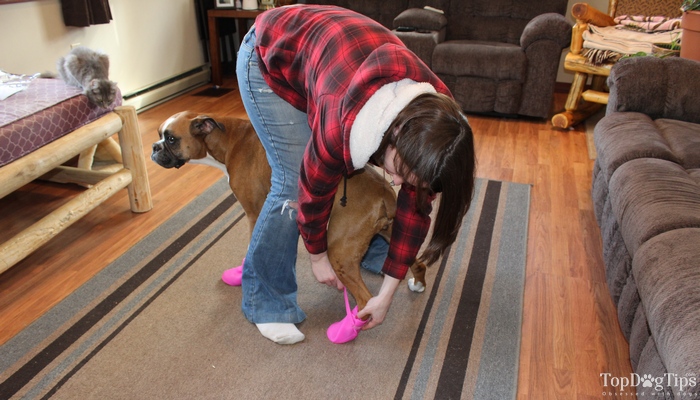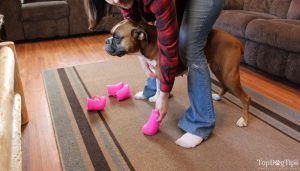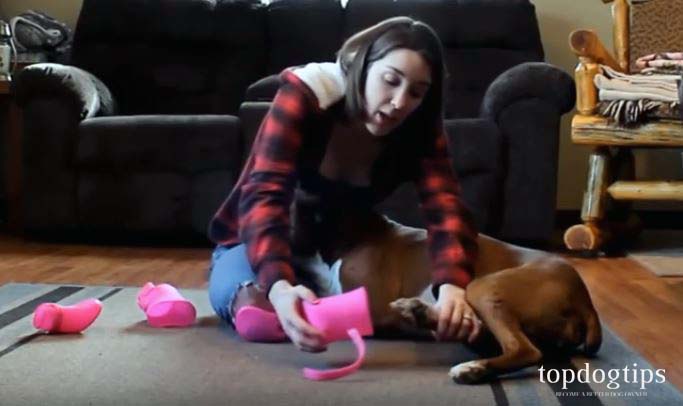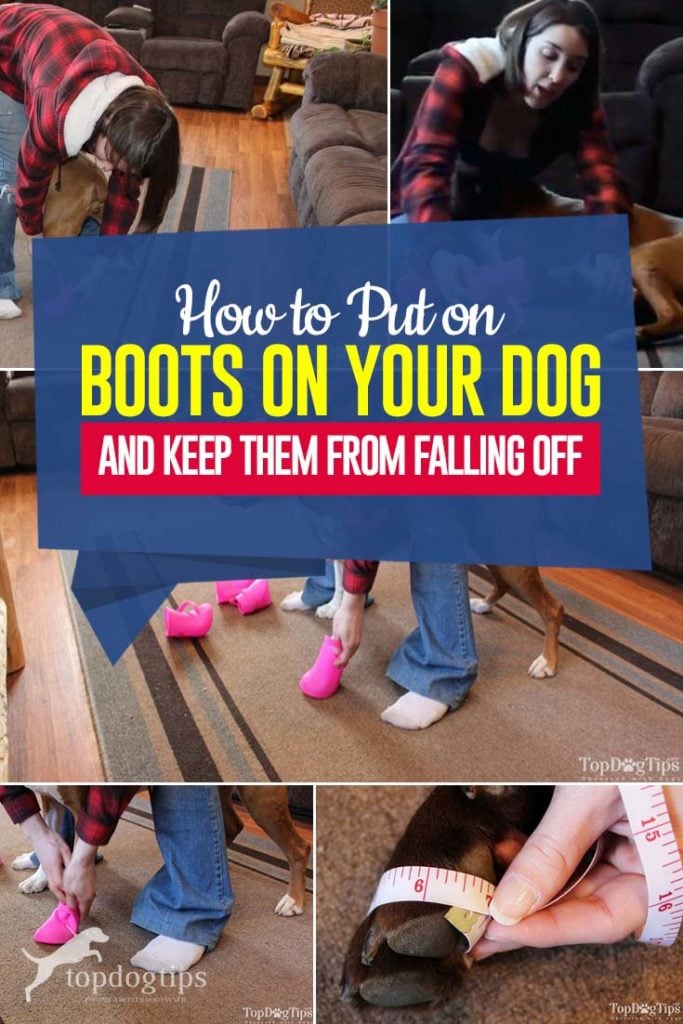You want your dog to wear booties, but how in the world do you get them to stay on? You're not alone in this, and many dog owners have problems with putting dog boots on their pet's paws, especially with squirmy pups that don't like having their paws touched. Below, I'll explain how to put on dog boots on a dog if it's your first time.
Why Do Dogs Need Booties?
There are a few (rare) cases when your pooch may need dog shoes, and those are seldom weather conditions.
Generally, a dog's paws are very utilitarian and can withstand most temperatures. A paw's thick outer skin with complex vein networks keeps them warm even during freezing weather. Each paw acts as its own regulator of heating and cooling, later spreading this to the rest of the dog's body.
The real danger are the things your pup steps on: hot asphalt, snow, ice, anti-icing salts, and other chemicals, very rough and rocky terrain. There's only so much protection actual paw pads can provide, and a set of dog booties may be needed based on where and when you're walking the dog. Then, they will also provide extra traction on ice.
Another, less important, the case is rainy days. In my video, you'll see I'm using waterproof silicon dog boots. You don't necessarily need waterproof boots for protection, but I like using them to keep my dogs' feet dry and clean when walking in the rain, with mud and wet debris around – it makes the cleaning process easier, and it's also for better traction.
Proper measurements and a good fit are essential to ensure dog booties are not only comfortable for the dog but also do their job of providing protection and traction. If you bought dog shoes before, you'll know that measuring instructions provided by the seller/brand won't always work. Every dog's paws are different (some are round with short toes, others have narrow paws with long toes). So here's how to pick the right fit, and how to put dog boots on a dog so that they stay.
How to Put On Dog Boots
1. Measure Your Dog's Paw Before Buying
Finding the right size dog boots is the hardest part of this process. Measuring your pup's paws is essential and I've made a separate video about this too.
Start by measuring the paw's circumference. You can use a simple fabric tape measure for this. Get the paw's widest part (do not measure down by the toes or up by the ankle).
Depending on when/where you plan to use dog booties (ice, snow, rain, hot asphalt, etc.), you may need to think about the booties' length, too. Measure for that the same way.
As for the height, start from the tip of the paw's toes and up the dog's leg. This will cover you in terms of buying the right size dog shoes.
2. Buy the Right Type of Dog Booties
Buying the right type is easier than the right size, but sometimes it still takes trial and error.
If you don't want to keep purchasing and returning the items, I would suggest going by brand recognition and investing a little extra into a set of more expensive shoes with good reviews, which are more likely to be a proper fit, comfy for the dog and last longer.
I've tried many, and my favorite brands are Ruffwear, Muttluks, and Qumy.
| Preview | Product | Rating | |
|---|---|---|---|

|
RUFFWEAR - Grip Trex, Blue Spring, 3.0 in (4... | 641 Reviews | Check Price |

|
Muttluks, Original Fleece-Lined Muttluks Winter... | 811 Reviews | Check Price |

|
QUMY Dog Shoes for Large Dogs, Medium Dog Boots &... | 30,812 Reviews | Check Price |
Ruffwear booties are the most expensive here, but the company is known for their quality. Their “Grip Trex” is great for any occasion, particularly for rough terrain and ice/snow. You'll see how their outsoles feel most rugged and flexible compared to others. You don't always need that, but it's never a disadvantage to have this on a dog bootie. They're good for both summer and winter.
Muttluks booties are cheaper and slightly different. They're not as rugged, and don't have the outsoles that would withstand really rough terrain. Instead, they're designed to keep the dog's paws warm and dry. As mentioned, canine paws only need extra help in freezing temperatures, so if that's the case, this would be my first choice.
QUMY booties are perfect for daily walks and protect your dog's paws against hurt from stones and asphalt. So, this is perfect for hiking. They also have two reflective straps, making your dog visible at night. This is important for your dog's safety, especially if you take him for night walks. The soles of the shoes are also anti-slip, providing stability and traction.

3. Putting Booties on a Dog's FRONT Legs
If your dog is as easygoing as my Boxer, Chloe, then it won't be difficult to get the dog booties on. But if your pooch is rambunctious, doesn't like you touching their paws, then ask someone to assist you.
Start slowly and give your pooch time to familiarize yourself with dog shoes. When your order arrives, lay them out on the floor and let the dog sniff them, get used to their look.
It's best to put boots on a dog when they're standing. This allows you to set the paw in the boot and place it flat on the floor. You'll get the right fit the first time, so there will be no need for adjustments.
To do this, straddle your dog facing its head (as pictured above). Have both front boots ready. This way you won't have the dog moving around while you're looking for the second boot.
Now, gently pick up the paw and place it inside the bootie.
Before you fasten the adjustable strap, ensure your dog's paw is flat on the floor and the boot is adjusted correctly. Fasten the strap tightly enough that the boot won't fall off, but not so tight that it is uncomfortable for the dog.
Follow the same procedure to put the dog boot on the other front paw.

4. Putting Booties on a Dog's REAR Legs
Now you'll need to turn around and straddle your dog so you're facing their back end.
Again, have both dog booties ready. Follow the same procedure as above with each back paw. Be sure that you're placing the paw flat on the floor and that the boot is adjusted properly before you fasten the straps.
When you're learning how to put on dog boots for the first time, your pooch may not be as cooperative as my Chloe. In that case, start by putting on one dog shoe at a time and then allowing them time to get used to that one before you put on the next one.
Side Note: After you bought a set of dog booties, it's just a matter of getting them onto your pup's feet. As you see in my video, maybe it's a little intimidating in the beginning, but overall, first-time learning how to put on dog boots and keep them from falling off isn't as complicated as you may think. When you put dog boots on multiple times a day, a few minutes each time, your pet will start getting used to the feel of booties very quickly, and they'll begin feeling calmer. Stay patient.
5. Putting Booties on a Lying or Sitting Dog
If the above technique fails, you can put the dog shoes on when your pup is lying down.
I show an example of this in my video above. It's a simple process, but be sure that after you put the boot on that you're pushing the base of the paw against your palm and adjusting the bootie properly.
When you're trying to learn how to put on dog booties on a dog when they're lying down, you'll need to adjust the boots after the dog stands up and places their paws flat on the floor.
Watch how your pet walks for the first few steps after you're done:
- Do you notice that any of the boots are turned to one side or the other? If so, make the necessary adjustment so they're facing the right way.
- Are your dog's feet pushed all the way, to the end of the boots? If not, you'll need to make the necessary adjustments here too.
These small issues may pop up when putting dog boots on a lying/sitting dog, which is why I recommend putting on booties while the dog is standing. That way you know you'll get them on correctly the very first time and won't need to keep messing with them.
READ NEXT: 5 Best Socks for Dogs to Keep Paws Protected and Warm
Disclosure: We may earn affiliate commissions at no cost to you from the links on this page. This did not affect our assessment of products. Read more here and find full disclosure here.
















